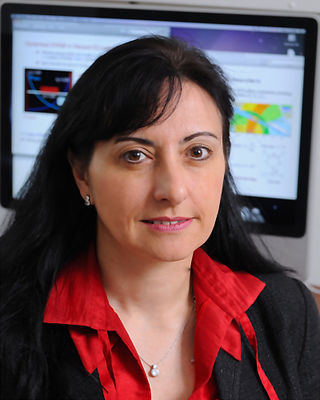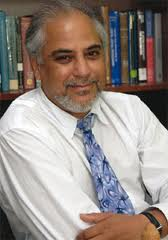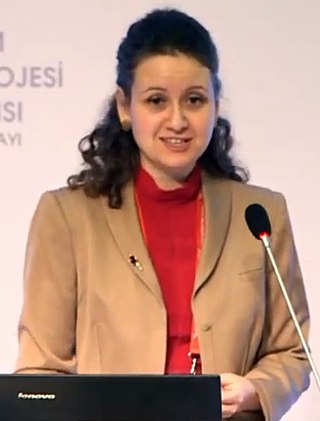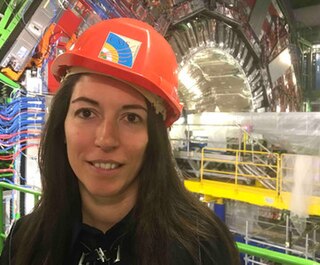Related Research Articles

The European Organization for Nuclear Research, known as CERN, is an intergovernmental organization that operates the largest particle physics laboratory in the world. Established in 1954, it is based in Meyrin, western suburb of Geneva, on the France–Switzerland border. It comprises 24 member states. Israel, admitted in 2013, is the only non-European full member. CERN is an official United Nations General Assembly observer.

Carlo Rubbia is an Italian particle physicist and inventor who shared the Nobel Prize in Physics in 1984 with Simon van der Meer for work leading to the discovery of the W and Z particles at CERN.

Jonathan Richard "John" Ellis is a British-Swiss theoretical physicist.

Marcela Silvia Carena Lopez is an Argentine theoretical physicist, and since November 2024 the Executive Director of the Perimeter Institute for Theoretical Physics in Waterloo, ON, Canada. Prior to taking this position she was a Distinguished Scientist at the Fermi National Accelerator Laboratory in Batavia, Illinois, where she was Director of the lab's Theory Division. She is also a professor at the University of Chicago, where she is a member of the Enrico Fermi Institute and the Kavli Institute for Cosmological Physics.

Sulamith Goldhaber (Hebrew: שולמית גולדהבר; November 4, 1923 – December 11, 1965), née Low, was a high-energy physicist and molecular spectroscopist. Goldhaber was a world expert on the interactions of K+ mesons with nucleons and made numerous discoveries relating to it.
Engin Arık was a Turkish particle physicist and professor at Boğaziçi University. She led the Turkish participation in a number of experiments at CERN. Arık was a prominent supporter of Turkey's membership to CERN and the founding of a national particle accelerator center as a means to utilize thorium as an energy source. She has also represented Turkey at the Comprehensive Nuclear Test Ban Treaty Organization for a number of years. She died in the Atlasjet Flight 4203 crash on November 30, 2007.

Swapan Chattopadhyay CorrFRSE is an Indian American physicist. Chattopadhyay completed his PhD from the University of California (Berkeley) in 1982.

The National Centre for Physics is a federally funded research institute and national laboratory co-located near Quaid-i-Azam University in Pakistan

Sau Lan Wu is a Chinese-American particle physicist and the Enrico Fermi Distinguished Professor of Physics at the University of Wisconsin-Madison. She made important contributions towards the discovery of the J/psi particle, which provided experimental evidence for the existence of the charm quark, and the gluon, the vector boson of the strong force in the Standard Model of physics. Recently, her team located at the European Organization for Nuclear Research (CERN), using data collected at the Large Hadron Collider (LHC), was part of the international effort in the discovery of a boson consistent with the Higgs boson.

Tara Georgina Shears is a Professor of Physics at the University of Liverpool.

Maria Fidecaro (1930-2023), née Cervasi, was an Italian experimental physicist with a focus on particle physics. She has spent most of her career at CERN, where she after retirement had the status of honorary member of the personnel.
Vera G. Lüth is an experimental particle physicist and professor emerita at Stanford Linear Accelerator Center (SLAC), Stanford University, in the United States. A senator of the Helmholtz Association, she has worked in particle physics at SLAC since 1974. She is a fellow of the American Physical Society.
Sanja Damjanović is a physicist from Montenegro and was minister of science in the government of Montenegro from 2016 until 2020.

Dilhan Eryurt was a Turkish astrophysicist who made major contributions to scientific research on the formation and evolution of the Sun and other main sequence stars.

Bilge Demirköz is a Turkish professor of high energy physics at Middle East Technical University. She coordinates the Particle Radiation Tests Creation Laboratory, the first collaboration between Turkey and CERN, the European Organization for Nuclear Research.

Beate Heinemann is a German particle physicist who has held positions at universities in Europe and the United States. She is the Director in charge of Particle Physics at the DESY laboratory in Hamburg and full professor of particle physics at the university of Hamburg.
Nan Phinney is a retired American accelerator physicist at SLAC. She was program coordinator for the Stanford Linear Collider (SLC), the world's first linear collider. Her research interests are high energy colliders and linear colliders. She became an American Physical Society Fellow in 1993. Her last job title at SLAC was "Distinguished Staff Scientist".
Giulia Zanderighi is an Italian-born theoretical physicist born in 1974 in Milan, Italy. She is the first woman director at the Max Planck Institute for Physics.

Archana Sharma is a distinguished Indian physicist and senior scientist at the CERN in Geneva, Switzerland. Her research focuses on high energy physics. She is internationally recognized for her work in instrumentation and gaseous detectors, specifically for her pioneering work on micro-pattern gaseous detectors. She received the Pravasi Bharatiya Samman Award in 2023 for her contribution in science and technology.

Florencia Canelli is since 2021 the appointed Swiss scientific delegate to the CERN council, the supreme decision-making authority of the CERN Organization. From 2021-2024, she was appointed chair of the IUPAP division of particles and field (C11). From 2021-2023, she was co-coordinator of the physics program of the CMS collaboration, a CERN experiment with over 3000 physicists. In 2010, Canelli was awarded the IUPAP Young scientist prize, an international prize awarded to one experimental and one theoretical physicist per year, for "her pioneering contribution to the identification and precision measurements of rare phenomenon through the use of advanced analysis techniques to separate very small signals from large background processes at the Tevatron collider." She has been an author on four multi-purpose collider experiments, namely the CMS experiment and ATLAS experiment at the CERN LHC, and the CDF experiment and D0 experiment at the Fermilab Tevatron. She is currently a full professor at the University of Zurich, Physics Institute, specializing in particle physics.
References
- ↑ "Dünyanın konuştuğu Türk: Prof. Dr. Hatice Duran Yıldız". Star.com.tr (in Turkish). 29 Dec 2021. Retrieved 4 Dec 2024.
- ↑ "Dünyanın konuştuğu Türk! Prof. Dr. Hatice Duran Yıldız: CERN araştırmaları dünyada ses getirdi". Gazete Vatan (in Turkish). 29 Dec 2021. Archived from the original on 3 Aug 2024. Retrieved 4 Dec 2024.